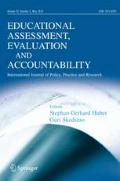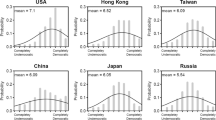Abstract
This article tests whether the form of decision-making used in school environments affects pupils’ views on the legitimacy of the decisions made, and of the decision-making procedure. Building on political science theory on democratic decision-making, it compares pupils’ reactions towards decisions made by pupil councils, by pupils via referendum, and by the teaching staff. The data come from a series of randomized scenario-style experiments in which participants (Swedish pupils involved in upper secondary education) were exposed to a questionnaire describing a decision-making situation. The results show that the form of decision-making used matters for pupils’ acceptance of the decision-making procedure, but not necessarily for their willingness to accept the outcome of decisions. Pupil referenda in particular were effective in creating procedural legitimacy.
Similar content being viewed by others
Notes
To make our point we are simplifying the procedural position. For an introduction to more complex reasoning, see, for example, Held (2006).
The correlation (Pearson’s r) between the two indexes is fairly high (the average for all six experiments is .62 with a high of .70 and a low of .58). However, the principal components analyses accomplished (varimax rotation, eigenvalues between 0.8 and 1.0) all produce the two expected factors.
In the initial three experiments some participants were told that decision X was taken while some were told that decision Y was taken, meaning that there were two kinds of winners and two kinds of losers. In the three later experiments (all built on the question of whether to ban religious symbols), all participants were told that the decision made was to ban religious symbols, meaning that there was one kind of winners and one kind of losers.
A series of tests shows that the processes of randomization worked well. In fact, none of the five variables that were tested in each of the six experiments (gender, political interest, left-right opinion, social class and ethnicity) showed statistically significant differences with the threshold set at p < .10.
The hypothesis is tested by means of a two-way analysis of variance (ANOVA) and a 2 (win/lose) x 3 (decision form) factorial design.
The difference between the teaching staff decision and the pupil council decision in the mobile phone study is the non-significant exception (difference of means = 0.31; p = .41).
In the Stanford Encyclopedia of Philosophy, Axel Gosseries (2005) makes the interesting point that “we do not have today a clear theory telling us why we should have secret ballots for electors and open votes in plenary parliamentary sessions.”
We have again conducted a two-way analysis of variance (ANOVA) of a 2 (type of discussion) x 2 (decision form) factorial design.
We also checked for possible interaction effects of the outcome variable (win/lose). However, none of the four interaction effects with the outcome variable involved (one from a two-way analysis of variance and three from a three-way analysis of variance) are statistically significant.
The important exception is, of course, the United States, where a majority of the states have some kind of recall procedure at the state and/or local level, which provides the voters with the possibility to remove and replace elected officials.
At the end of both scenarios some pros and cons for the two forms of pupil councils were presented.
This analysis as well as the following one are based on a one-way analysis of variance (ANOVA).
Once again, this time there are no signs of an interaction effect between the form of decision-making chosen and the outcome variable. In other words, the difference (and non-difference, respectively) in acceptance between decision-making with bounded and unbounded mandates is more or less the same among winners as among losers.
Also this time, the scenarios were concluded with a presentation of some pros and cons for each form of decision-making.
Once again, we checked the results for potential interaction effects of the decision outcome variable (win/lose) but without success. In other words, the differences in acceptance among pupils between the three forms of decision-making outlined in Table 4 is the same among winners as among losers.
References
Alderson, P. (2000). School students’ views on school councils and daily life at school. Children & Society, 14, 121–34.
Almgren, E. (2006). Att fostra demokrater. Om skolan i demokratin och demokratin i skolan. Uppsala: Acta Universitatis Upsalienis.
Aronson, E., Wilson, T., & Brewer, M. (1998). Experimentation in social psychology. In D. Gilbert, S. Fiske & G. Lindzey (Eds.), The handbook of social psychology (4th ed.). New York: McGraw Hill.
Audigier, F. (1999). Basic concepts and core competencies of education for democratic citizenship. Strasbourg: Council of Europe.
Brennan, G., & Pettit, P. (1990). Unveiling the vote. British Journal of Political Science, 20, 311–33.
Bäck, H., & Gilljam, M. (2006). Valdemokratins mekanismer. In H. Bäck & M. Gilljam (Eds.), Valets mekanismer. Malmö: Liber.
Cockburn, T. (1999). Children, fooles and mad-men. Children’s relationship to citizenship in Britain from Thomas Hobbes to Bernard Crick. School Field, 10, 65–83.
Cronin, T. (1989). Direct democracy. The politics of initiative, referendum, and recall. Cambridge: Harvard University Press.
Dahl, R. (1989). Democracy and its critics. New Haven: Yale University Press.
Davies, L. (1998). School councils and pupil exclusions. London: School Councils UK.
Davies, L., & Kirkpatrick, G. (2000). The Euridem project: A review of pupils democracy in Europe. University of Birmingham: School of Education.
Deuchar, R (2008). Seen and heard, and then not heard: Scottish Pupils’ experience of democratic educational practice during the transition from primary to secondary school. Oxford Review of Education 1–18.
Dewey, J. (1916). Democracy and education. New York: The Free.
Dürr, K. (2005). The school: A democratic learning community. The all-European study on pupils’ participation in school. Council of Europe: Strasbourg.
Englund, T. (2003). Rethinking democracy and education. Towards and education of deliberative citizens. In W. Carr (Ed.), The Routledge Falmer reader in philosophy of education. London: Routledge.
Esaiasson, P., & Holmberg, S. (1996). Representation from above. Members of parliament and representative democracy in Sweden. Dartmouth: Aldershot.
Esaiasson, P., Gilljam, M., & Lindholm, T. (2009). When winning is everything. Citizens’ acceptance of democratic policy decisions. University of Gothenburg: Department of Political Science (unpublished manuscript).
Flecknoe, M. (2002). Democracy, citizenship and school improvements: what can one school tell us? School, Leadership & Management, 22, 421–37.
Flutter, J., & Rudduck, J. (2004). Consulting pupils: What’s in it for Schools. London: Routledge Falmer.
Gilljam, M. (2003). Deltagardemokrati med förhinder. In M. Gilljam & J. Hermansson (Eds.), Demokratins mekanismer. Malmö: Liber.
Gosseries, A. (2005). “Publicity”. Stanford Encyclopedia of Philosophy.
Held, D. (2006). Models of democracy (3rd ed.). Stanford: Stanford University Press.
Hochschild, J., & Scovronick, N. (2000). Democratic education and the American dream. In L. McDonnell, M. Timpane & R. Benjamin (Eds.), Rediscovering the democratic purposes of education. Lawrence: University Press of Kansas.
Knight, T. (2001). Longitudinal developments of educational theory: democracy and the classroom. Journal of Educational Policy, 16, 249–63.
Lijphart, A. (2000). Turnout. In R. Rose (Ed.), International encyclopedia of elections. Oxford: MacMillan.
Lind, A., & Tyler, T. (1988). The social psychology of procedural justice. London: Plenum.
Lupia, A., & Matsusaka, J. (2004). Direct democracy: new approaches to old questions. Annual Review of Political Science, 7, 463–82.
Manin, B. (1997). The principles of representative government. Cambridge: Cambridge University Press.
Maitles, H., & Deuchar, R. (2006). We don’t learn democracy, We live it! Education, Citizenship and Social Justice, 1, 249–66.
Morrell, M. (1999). Citizens’ evaluations of participatory democratic procedures: normative theory meets empirical science. Political Research Quarterly, 52, 293–322.
Oscarsson, H. (ed.) (2001). Skilda valdagar och vårval. Forskningsrapporter utgivna av 1999 års Författningsutredning. Stockholm: SOU 2001:65.
Ostler, A. (2000). Children’s rights, responsibilities and understandings of school discipline. Research Papers in Education, 15, 49–67.
Ostler, A., & Starkey, H. (2006). Education for democratic citizenship: A review of research, policy and practice 1995–2005. Research Papers in Education, 21, 433–66.
Pateman, C. (1970). Participation and democratic theory. Cambridge: Cambridge University Press.
Phillips, A. (1995). The politics of presence. Oxford: Oxford University Press.
Potter, J. (2002). Active citizenship in schools. London: Kogan Page.
Print, M. (2007). Citizenship education and youth participation in democracy. British Journal of Educational Studies, 55, 325–45.
Print, M., Ørnstrøm, S., & Nielsen, H. S. (2002). Education for democratic processes in schools and classrooms. European Journal of Education, 2, 193–210.
Ross, H., Munn, P., & Brown, J. (2007). What counts as student voice in active citizenship case studies? education for citizenship in Scotland. Education, Citizenship and Social Justice, 2, 237–56.
Rowe, D. (2003). The business of school councils: An investigation into democracy in schools. London: Citizenship Foundation.
Taylor, M., & Johnson, R. (2002). School councils: Their role in citizenship and personal and social education. Berkshire: NFER.
Teorell, J. (2001). Kan politiken bli en plikt? Om tvång, lotteri och demokrati. Stockholm: SNS.
Torney-Purta, J. (2002). The school’s role in developing civic engagement: A study of adolescents in twenty-eight countries. Applied Developmental Science, 5, 203–12.
Torney-Purta, J., Lehman, R., Oswald, H., & Schulz, W. (2001). Citizenship and education in twenty-eight countries. Civic knowledge and engagement at age fourteen. IEA: Amsterdam.
Trafford, B. (2003). School councils, school democracy, school improvement: Why, What, How. Leicester: Secondary Heads Association.
Tyler, T., Boeckmann, R., Smith, H., & Huo, Y. (1997). Social justice in a diverse society. Boulder: Westview.
Tyler, T. (2000). Social justice: outcome and procedure. International Journal of Psychology, 35, 117–25.
Tyler, T. (2006). Psychological perspectives on legitimacy and legitimation. Annual Review of Psychology, 57, 375–400.
Varnham, S. (2005). Citizenship in schools: the gap between theory and practice. Education and the Law, 17, 53–64.
Wahlke, J., Eulau, H., Buchanan, W., & Ferguson, L. (1962). The legislative system. Explorations in legislative behavior. New York: Wiley & Sons.
Warren, M. (1992). Democratic theory and self-transformation. American Political Science Review, 86, 8–23.
Young, I. M. (1996). Communication and the other: Beyond deliberate democracy. In S. Benhabib (Ed.), Democracy and difference: Contesting the boundaries of the political. Princeton: Princeton University Press.
Acknowledgement
The authors want to thank Ola Jodal, Martin Johansson, Jakob Lindahl, Erika Litzén and Anders Sundell for their excellent research assistance, and Mikael Alexandersson, Klas Andersson, Carl Dahlström, Anders Fredriksson, Maria Jarl, Erik Moberg and Daniel Naurin for valuable comments and suggestions on an earlier draft of this article.
Author information
Authors and Affiliations
Corresponding author
Rights and permissions
About this article
Cite this article
Gilljam, M., Esaiasson, P. & Lindholm, T. The voice of the pupils: an experimental comparison of decisions made by elected pupil councils, pupils in referenda, and teaching staff. Educ Asse Eval Acc 22, 73–88 (2010). https://doi.org/10.1007/s11092-009-9084-0
Received:
Accepted:
Published:
Issue Date:
DOI: https://doi.org/10.1007/s11092-009-9084-0




